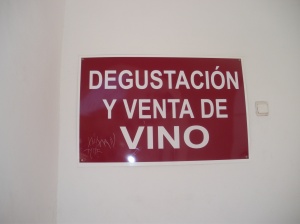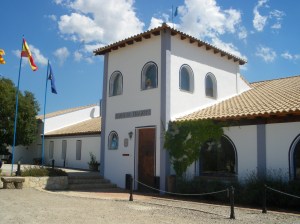 The wine-growing area of Utiel-Requena (DO) was once dedicated to producing the sort of plonk that gave Spanish wine such a bad name but now a new generation of enologists are establishing new wineries or transforming old ones to produce some outstanding wines including cavas. (Utiel Requena is the only wine region outside Catalunya that is entitled to a “cava” denomination.) It’s just about an hour and a half from home (about 40 minutes north-west of Valencia city) so we set off recently on a wine tour.
The wine-growing area of Utiel-Requena (DO) was once dedicated to producing the sort of plonk that gave Spanish wine such a bad name but now a new generation of enologists are establishing new wineries or transforming old ones to produce some outstanding wines including cavas. (Utiel Requena is the only wine region outside Catalunya that is entitled to a “cava” denomination.) It’s just about an hour and a half from home (about 40 minutes north-west of Valencia city) so we set off recently on a wine tour.  We visited two wineries, the Pago de Tharsys, a 200-year old estate now run by Vicente Garcia, a French-trained winemaker and his wife Ana Suria. They produce limited edition wines using only grapes grown inside their own vineyards, employing traditional methods and the most sophisticated technological installations. Interestingly, they harvest their grapes at night when temperatures are low. The climate here is extreme, scorching summers and severe winters. We hadn’t made a booking but were made very welcome, given a tour of the vineyards and the winery and ended up tasting and buying some great tinto and cava.
We visited two wineries, the Pago de Tharsys, a 200-year old estate now run by Vicente Garcia, a French-trained winemaker and his wife Ana Suria. They produce limited edition wines using only grapes grown inside their own vineyards, employing traditional methods and the most sophisticated technological installations. Interestingly, they harvest their grapes at night when temperatures are low. The climate here is extreme, scorching summers and severe winters. We hadn’t made a booking but were made very welcome, given a tour of the vineyards and the winery and ended up tasting and buying some great tinto and cava.
Our second visit was to the Torre Oria bodega – a lovely old modernista estate designed in 1897 by the Valencian architect Jose Donderis who also built the train station in Valencia , the Estacion del Norte, and the Mercado Central. As well as tours of the estate, they also run one-day wine-tasting courses here so if you are on holiday in the Valencian area and want a change from the beach, the restaurants, the architecture, the art and the music of the city, you could spend a day or two in Utiel Requena. There are dozens of other bodegas on the “Ruta de Vino”.  The town of Requena itself was a revelation. Under the old city, within the walls of what was a Moorish town, there is a vast complex of tunnels and galleries. These date from the eighth century and were excavated by families in the old city to be used as warehouses. When the Moors, or more correctly moriscos, were finally driven out of Valencia in the expulsions of 1609, the city was abandoned. Later in the seventeenth century when it was repopulated, the underground tunnels were rediscovered and used for the storage of wine, the manufacture of the large ceramic storage vessels – “tinajas”, many of which are still there – and even as an ossuary for bones when the crypts of the local churches were too full. Legend has it that the tunnels were also used as a refuge during the Civil War. The visit takes about an hour and is well worth it.
The town of Requena itself was a revelation. Under the old city, within the walls of what was a Moorish town, there is a vast complex of tunnels and galleries. These date from the eighth century and were excavated by families in the old city to be used as warehouses. When the Moors, or more correctly moriscos, were finally driven out of Valencia in the expulsions of 1609, the city was abandoned. Later in the seventeenth century when it was repopulated, the underground tunnels were rediscovered and used for the storage of wine, the manufacture of the large ceramic storage vessels – “tinajas”, many of which are still there – and even as an ossuary for bones when the crypts of the local churches were too full. Legend has it that the tunnels were also used as a refuge during the Civil War. The visit takes about an hour and is well worth it. 
 Book Recommendation: For anyone interested in the history of Islamic Spain, I recommend two books by L.P. Harvey, published by the University of Chicago – Islamic Spain, 1250-1500 and Muslims in Spain 1500-1614
Book Recommendation: For anyone interested in the history of Islamic Spain, I recommend two books by L.P. Harvey, published by the University of Chicago – Islamic Spain, 1250-1500 and Muslims in Spain 1500-1614
